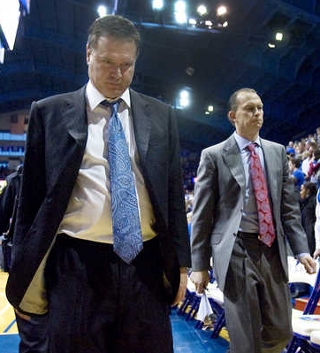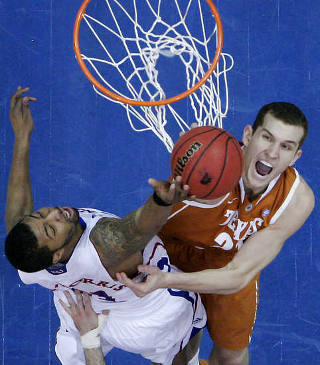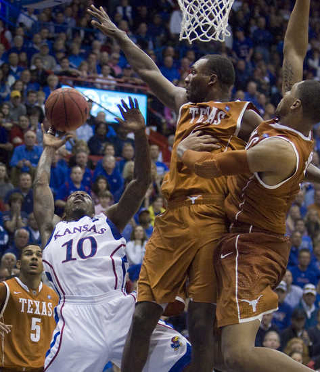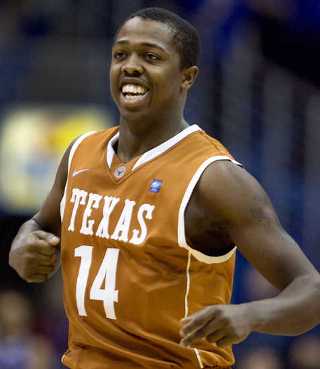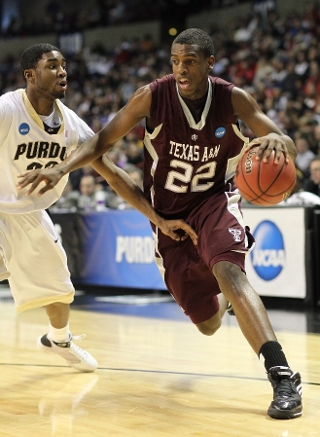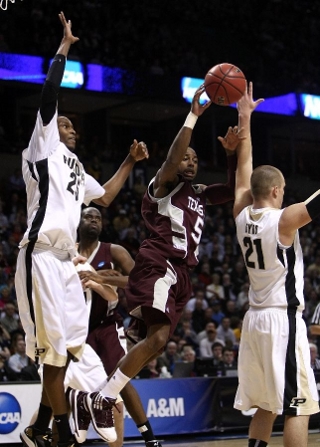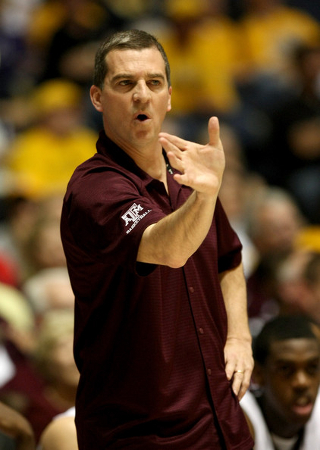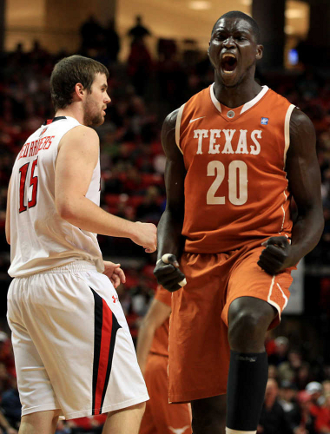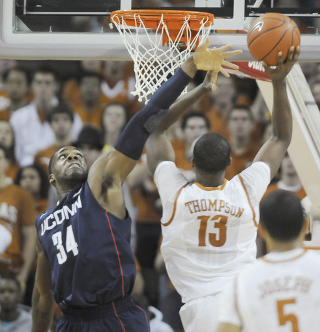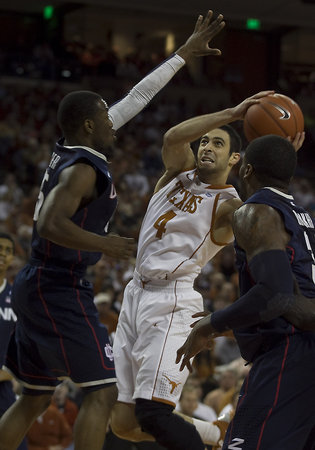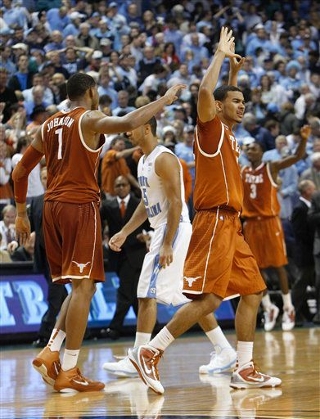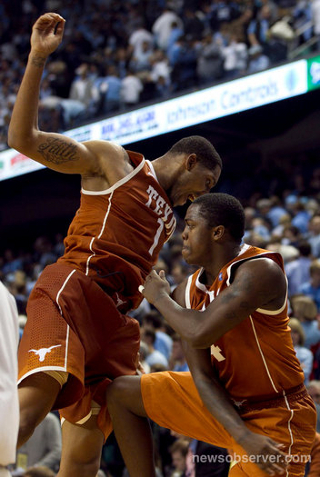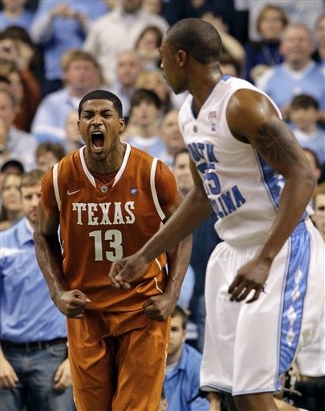Things were different in Allen Fieldhouse on Saturday afternoon. There was no “Rock, Chalk, Jayhawk.” There was no waving of the wheat. There was simply stunned silence and a mass exodus that began with more than a minute left on the clock. The air was filled with a mix of confusion, dejection, and disgust. One of the things taken for granted in the Midwest, a certainty on par with the sun rising each day, was suddenly turned on its head. Kansas had finally lost at home.
Bill Self and KU suffered their first home loss in four years There is a banner that greets all opponents when they arrive to Allen Fieldhouse. “Take heed, all who enter,” it warns. “Beware the Phog.” It’s a place worthy of the cautionary signage. Texas’ 74-63 win was the first by a visiting opponent in the last 70 games, and just the second in the last 90 games. Beyond the historical implications, the win was huge for the Longhorns because it left them as the sole undefeated team in Big 12 play. One quarter of the way through the league schedule, Texas is one game ahead in the loss column of both Texas A&M and Kansas, both teams that the Longhorns now hold the head-to-head advantage over. The Aggies and Longhorns will meet again in College Station a week from Monday. In terms of NCAA seeding, the win also gave the Longhorns their third big road victory, and fourth win over a team ranked 25th or better by statistician Ken Pomeroy. The Bracket Project’s Bracket Matrix shows that of the seven bracket projections which have been updated since the win, four have the Longhorns moving onto the 2-seed line. Inside the numbers The initial moments of the game were soul-crushing for even the most optimistic of Longhorn fans. Kansas took a dominating lead early behind the hot shooting of three-point gunner Tyrel Reed, while the Longhorns couldn’t even sink a basket for more than three minutes. By the first media timeout, the Jayhawks were up 12-2, and even added a free throw coming out of the break.
Matt Hill had a big defensive game for Texas But after the initial turbulence, the Longhorns settled in and imposed their will on the Jayhawks. The stout Texas defense deterred the Kansas guards from even attempting dribble penetration, and they settled for a simple high-low game with no wrinkles. Bring the ball down the court, dump it in to the post, hope that Robinson or a Morris twin could score. Rinse. Repeat. Fortunately for Texas, Matt Hill had the best zero-point performance in Texas history. He grabbed four defensive rebounds and used every one of his five fouls, forcing the Kansas bigs to earn their points at the line. As it is for Texas, the charity stripe is more like a demented carnival funhouse for Kansas, and the Brothers Morrii combined to sink just 9 of 16 from the line. The most telling statistic came in the form of efficiency numbers. Heading into the game, the Jayhawks were scoring an adjusted 1.182 points per possession. They were coming off of an absolute drubbing of Baylor, a road win in which they put on an offensive clinic and scored an insane 1.337 points each time down the floor. Against the Longhorns, the Jayhawks managed just 0.879 points per trip, a loss of more than 25% of their typical offensive production. The story was the exact same on the other side of the basketball. Kansas was limiting opponents to just 0.829 points per possession heading into yesterday afternoon’s game. For the first five minutes, it looked like the Longhorns would suffer the same fate. As the Jayhawks built an early fifteen point lead, Texas managed just three points in ten possessions, due in large part to three turnovers and an inability to rebound their misses.
The Texas defense stifled Kansas down the stretch That would be the end of Kansas’ dominance, however. Texas stayed within arm’s reach of the Jayhawks until halftime, and then dropped 51 second-half points on the home team, the most Kansas has allowed in a half since February 9th, 2008. Despite the inauspicious start, the Longhorns finished the game with 1.033 points per possession, nearly 25% more than what the Jayhawks had allowed their previous opponents. On both sides of the ball, the Longhorns dictated the flow of the game. Grading the players Following a win like this, it’s tough to hand out anything but positive marks to the entire team. Even Gary Johnson, who had one of the toughest shooting games of his career, managed to fight through the adversity and hit a pair of clutch baskets. While Gary allowed the Morrii to grab a few key rebounds down the stretch, his jumper from the corner iced the game with 1:05 to play, and it came after he had started the game just 1-of-7. Feeding Gary on that jumper was Jordan Hamilton, who had the quietest 17-point performance in recent memory. He earned seven of his points at the line, but perhaps made the biggest impact by leading the team with nine rebounds. Following a technical foul called on him for taunting, Hamilton sat on the bench for nearly six minutes in the second half. It says a lot for this Texas team that with their star on the bench, they were still able to turn a seven-point deficit into a four-point lead.
J’Covan Brown was all smiles after scoring 23 points Without Hamilton, the Horns were powered by J’Covan Brown and Tristan Thompson. Brown scored 11 of Texas’ 16 points in that stretch, and finished with 23 points for the game. Thompson had three points and two rebounds with Hamilton on the bench, and posted 12 and six for the game. Against the Kansas frontcourt, that’s a big accomplishment in its own right. What was an even bigger accomplishment for the freshman was his 6-of-8 performance at the free-throw line, a place where he had made just 49.2% of his attempts heading into the game. Cory Joseph also played well after some initial jitters and an airball that drew a chant from the oversized Kansas student section. He finished with eleven points and made two three-pointers, including one that banked in off the glass as the shot clock expired. Just two weeks after Kemba Walker hit a miracle shot to beat the shot clock in Austin, it was as if the basketball gods just wanted to even things out for the Longhorns. With Brown and Joseph playing well, that left Dogus Balbay on the bench for much of the team’s furious rally. In conference play, Dogus is averaging just 15.5 minutes, while Brown has seen his playing time increase to more than 24 minutes per game. This new approach seems to give Texas the perfect two-headed guard, as Balbay provides excellent defense — he helped hold KU star Josh Selby to just four points — while Brown brings in the offensive spark from the bench. If these two continue to play at this level down the stretch, the Horns will be tough to beat. Next up: at Oklahoma State (14-5 overall, 2-3 Big 12); 6:30 P.M. CT, Wednesday |








